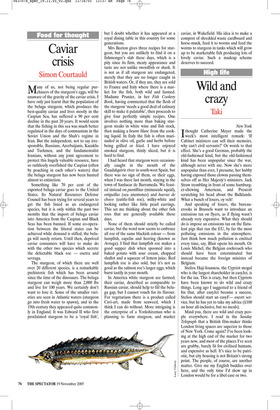Caviar crisis
Simon Courtauld
Many of us, not being regular purchasers of the sturgeon’s eggs, will be unaware of the gravity of the caviar crisis. I have only just learnt that the population of the beluga sturgeon, which produces the best-quality caviar and lives mostly in the Caspian Sea, has suffered a 90 per cent decline in the past 20 years. It would seem that the fishing in this sea was much better regulated in the days of communism in the Soviet Union and the Shah’s regime in Iran. But the independent, not to say irresponsible, Russians, Azerbaijanis, Kazakhs and Turkmen, and the fundamentalist Iranians, without any joint agreement to protect this hugely valuable resource, have so ruthlessly overfished the Caspian (often by poaching in each other’s waters) that the beluga sturgeon has now been hunted almost to extinction.
Something like 70 per cent of the exported beluga caviar goes to the United States. Its Natural Resources Defense Council has been trying for several years to get the fish listed as an endangered species, but it is only within the past two months that the import of beluga caviar into America from the Caspian and Black Seas has been banned. If some co-operation between the littoral states can be achieved while demand is stifled, the beluga will surely return. Until then, deprived caviar consumers will have to make do with the other two species which secrete the delectable black roe — osetra and sevruga.
The sturgeon, of which there are well over 20 different species, is a remarkable prehistoric fish which has been around since the time of the dinosaurs. The beluga sturgeon can weigh more than 2,000 lbs and live for 100 years. We certainly don’t want to lose it. Some of the smaller varieties are seen in Atlantic waters (sturgeon go into fresh water to spawn), and in the 19th century they appeared quite commonly in England. It was Edward II who first proclaimed sturgeon to be a ‘royal fish’, but I doubt whether it has appeared at a royal dining table in this country for some generations.
Mrs Beeton gives three recipes for sturgeon, but you are unlikely to find it on a fishmonger’s slab these days, which is a pity since its firm, meaty appearance and taste are not unlike swordfish or shark. It is not as if all sturgeon are endangered, merely that they are no longer caught in British waters. Or, if they are, they are sold to France and Italy where there is a market for the fish, both wild and farmed. Madame Prunier, in her Fish Cookery Book, having commented that the flesh of the sturgeon ‘needs a good deal of culinary skill to make it palatable’, then proceeds to give four perfectly simple recipes. One involves nothing more than baking sturgeon steaks in white wine and fish stock, then making a beurre blanc from the cooking liquid. In Italy the fish is often marinaded in olive oil, garlic and herbs before being grilled or fried. I have enjoyed smoked sturgeon, thinly sliced, but it is hard to find.
I had heard that sturgeon were occasionally caught in the mouth of the Guadalquivir river in south-west Spain, but there was no sign of them, or their eggs, when I was there last month, staying in the town of Sanlucar de Barrameda. We feasted instead on puntillitas (minuscule squid), ortiguillas (sea anemones) and huevas de choco (cuttle-fish roe), milky-white and looking rather like little pearl earrings. This set me thinking about the other fish roes that are generally available these days.
None of them should strictly be called caviar, but the word now seems to embrace all roe of the same blackish colour — from lumpfish, capelin and herring (known as Avruga). I find that lumpfish roe makes a good supper dish when spooned into a baked potato with sour cream, chopped shallot and a squeeze of lemon juice. Red lumpfish roe is also sold, but it’s not as good as the salmon roe’s larger eggs, which burst tastily in your mouth.
In America white sturgeon are farmed; their caviar, described as comparable to Russian caviar, should help to fill the beluga gap, but I cannot vouch for its flavour. For vegetarians there is a product called Cavi-art, made from seaweed, which I think I can do without. More intriguing is the enterprise of a Yorkshireman who is planning to farm sturgeon, and market caviar, in Wakefield. His idea is to make a compost of shredded waste cardboard and horse-muck, feed it to worms and feed the worms to sturgeon in tanks which will grow up to be marketable fish producing lots of lovely caviar. Such a madcap scheme deserves to succeed.

























































 Previous page
Previous page